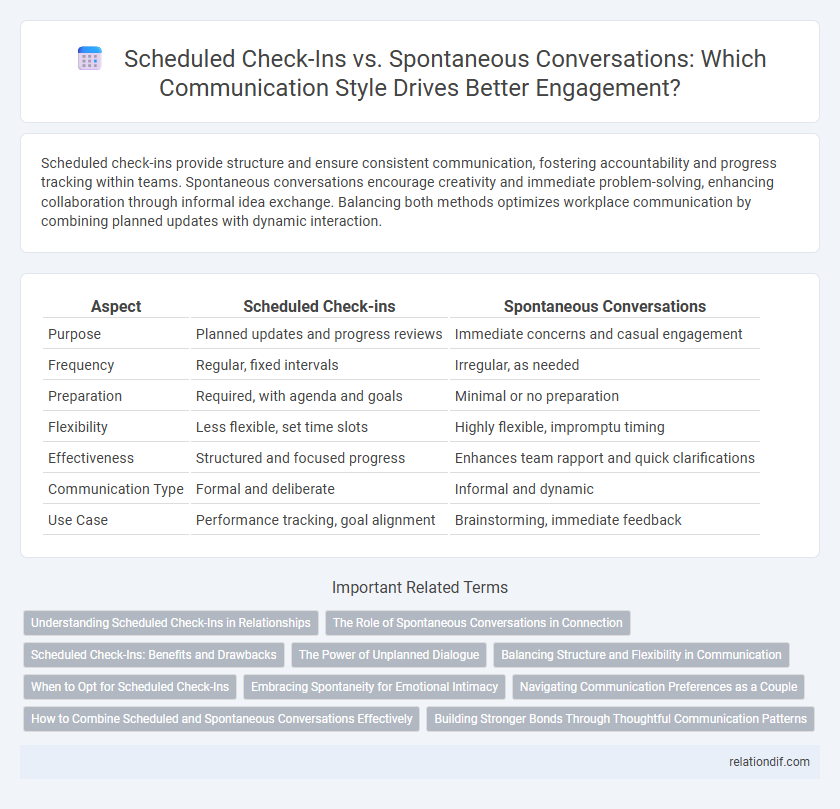Scheduled check-ins provide structure and ensure consistent communication, fostering accountability and progress tracking within teams. Spontaneous conversations encourage creativity and immediate problem-solving, enhancing collaboration through informal idea exchange. Balancing both methods optimizes workplace communication by combining planned updates with dynamic interaction.
Table of Comparison
| Aspect | Scheduled Check-ins | Spontaneous Conversations |
|---|---|---|
| Purpose | Planned updates and progress reviews | Immediate concerns and casual engagement |
| Frequency | Regular, fixed intervals | Irregular, as needed |
| Preparation | Required, with agenda and goals | Minimal or no preparation |
| Flexibility | Less flexible, set time slots | Highly flexible, impromptu timing |
| Effectiveness | Structured and focused progress | Enhances team rapport and quick clarifications |
| Communication Type | Formal and deliberate | Informal and dynamic |
| Use Case | Performance tracking, goal alignment | Brainstorming, immediate feedback |
Understanding Scheduled Check-Ins in Relationships
Scheduled check-ins in relationships provide a structured opportunity to discuss emotions, expectations, and concerns, fostering consistent communication and trust. These intentional conversations ensure both partners are aligned on goals and can address issues proactively before they escalate. Establishing routine check-ins strengthens emotional connection and supports long-term relational health.
The Role of Spontaneous Conversations in Connection
Spontaneous conversations play a crucial role in fostering authentic connections by enabling real-time, unscripted interactions that reveal genuine emotions and thoughts. These impromptu exchanges encourage trust and collaboration, often leading to innovative ideas and stronger relationships. Unlike scheduled check-ins, spontaneous talks create dynamic communication flows that enhance team cohesion and personal rapport.
Scheduled Check-Ins: Benefits and Drawbacks
Scheduled check-ins provide a structured opportunity for regular updates, performance reviews, and goal alignment, enhancing accountability and clarity in communication within teams. These meetings can foster focused discussions and ensure that key topics are addressed consistently, reducing misunderstandings and overlooked issues. However, reliance on scheduled check-ins may limit spontaneous idea sharing and reduce flexibility, potentially hindering the natural flow of collaboration and immediate problem-solving.
The Power of Unplanned Dialogue
Unplanned dialogue fosters authentic connections by encouraging spontaneity and genuine expression during communication. Scheduled check-ins often facilitate structure and accountability, but spontaneous conversations ignite creativity and quickly address emerging issues. Emphasizing unplanned dialogue enhances team dynamics by building trust and promoting a culture of openness.
Balancing Structure and Flexibility in Communication
Scheduled check-ins provide a structured framework for consistent updates and goal tracking, ensuring accountability and clarity among team members. Spontaneous conversations foster flexibility, encouraging creativity and immediate problem-solving that can enhance collaboration and innovation. Balancing these communication methods promotes an adaptive environment where reliability meets responsiveness, optimizing both productivity and relationship-building.
When to Opt for Scheduled Check-Ins
Scheduled check-ins are essential for maintaining structured communication in remote teams, ensuring timely updates and accountability while preventing overlooked tasks. These regular meetings facilitate goal alignment, progress tracking, and proactive problem-solving by providing a dedicated time slot for focused dialogue. Opt for scheduled check-ins in complex projects requiring coordinated efforts, formal reporting, and clear documentation of decisions.
Embracing Spontaneity for Emotional Intimacy
Spontaneous conversations foster emotional intimacy by allowing authentic, unplanned expressions that strengthen trust and connection between individuals. Unlike scheduled check-ins, these impromptu interactions capture real emotions and provide immediate support, enhancing relationship resilience. Embracing spontaneity in communication enriches emotional bonds and nurtures deeper understanding.
Navigating Communication Preferences as a Couple
Scheduled check-ins provide a structured opportunity for couples to address important topics and ensure consistent dialogue, fostering trust and understanding. Spontaneous conversations capture natural emotional expressions and promote intimacy through genuine, unplanned interactions. Balancing these communication styles helps partners navigate individual preferences and strengthen relational connection.
How to Combine Scheduled and Spontaneous Conversations Effectively
Balancing scheduled check-ins with spontaneous conversations enhances communication flexibility and responsiveness in teams. Establish fixed times for structured updates to ensure clarity and alignment while encouraging informal, impromptu discussions that foster creativity and immediate problem-solving. Integrating both methods optimizes information flow and strengthens team cohesion by addressing routine tasks and dynamic interactions effectively.
Building Stronger Bonds Through Thoughtful Communication Patterns
Scheduled check-ins create a reliable framework that fosters trust and accountability by ensuring consistent dialogue between team members or loved ones. Spontaneous conversations inject authenticity and emotional depth into relationships, allowing for genuine expression and problem-solving in real-time. Balancing these communication patterns enhances relational resilience and promotes deeper understanding through a blend of predictability and natural interaction.
Scheduled check-ins vs Spontaneous conversations Infographic

 relationdif.com
relationdif.com